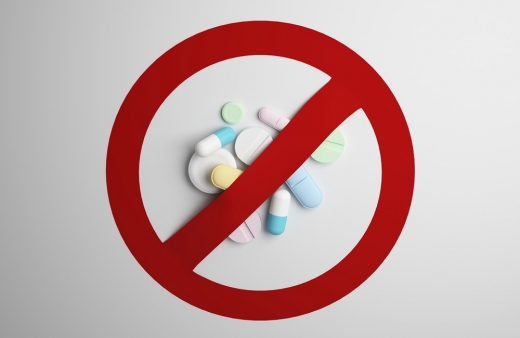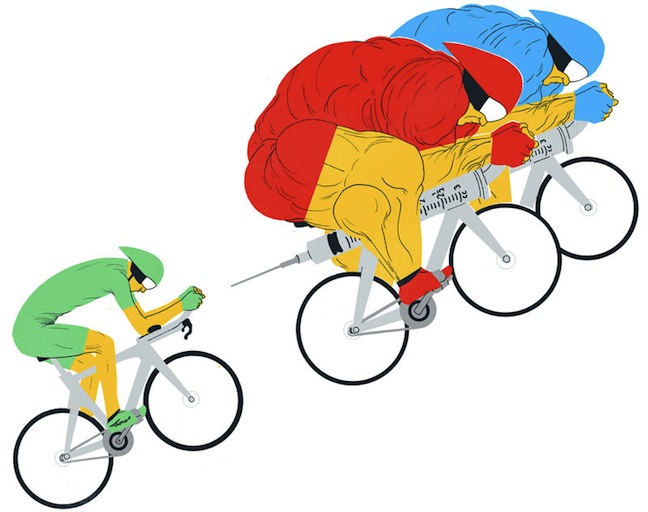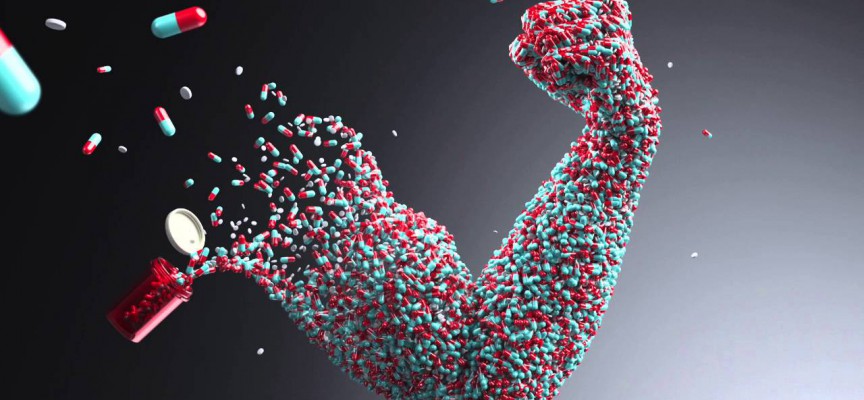Whenever and wherever there is an international sporting event, doping tests are prevalent. At the 2018 PyeongChang Winter Olympics, Russia was banned from competing in the event due to the national doping scandal. Indeed, Russian soccer player Denis Cheryshev was suspected of doping at the 2018 Russian World Cup. Thus, doping in sport has become a major concern amongst fans, and the shadow of controversy seems to hang over every major sporting event. International organizations appear to be in a state of constant reassessment regarding this situation.
What Is Doping?
 |
Doping refers to an athlete’s use of illegal drugs to improve their athletic performance. Because doping is harmful to the health and violates the spirit of sporting competition, it is forbidden by the International Olympic Committee (IOC) and the International Sport Federations. The Danish cyclist Knud Enemark Jensen, who participated in the Rome Summer Olympics in 1960, died during his race as a result of using an illegal stimulant. As a result, the International Olympic Committee introduced doping tests at the 1972 Olympic Winter Games in Sapporo. According to the World Anti-Doping Agency (WADA), the list of forbidden drugs, which consisted of only about 40 at the 1988 Seoul Olympics, has increased every year and now contains more than 450 drugs.
Doping tests are generally conducted some 12 hours before the start of an event or immediately after an event. In some instances, doping tests are conducted on a random basis regardless of whether there is an event or not. Indeed, doping tests are conducted without prior notice in order to prevent doping at all times during the Olympics or other major sporting events. A doping test usually takes the form of a urine test or blood test. Two samples of the player's urine are taken, one is examined directly at the venue and the other is frozen for 10 years and then will be retested. If new doping breach detection technology becomes available, the IOC may use the frozen sample for retesting and discover illegal drug abuse at a later date. In order to improve the accuracy of the tests, players’ blood is used to check for doping. Blood tests have been conducted since the 2000 Sydney Olympics.
2018 Russia World Cup - Russia
In the 2018 Russia World Cup, when the Russian national team beat Spain 4-1 in a penalty shoot-out to progress to the quarter-finals, the suspicion of doping was raised. The Russian players, on the day, displayed tremendous physical energy and endurance even though one player was given a red card. Russia's performance during the 120 minutes, including the first half and the second half of overtime, included a combined team distance ran of 146km, dwarfing the 137km ran by Spain. In particular, Russian striker Aleksandr Golovin (22) ran 15.9 km, which was the largest amount for the two teams, and other Russian players, including Sergey Ignashevich (38), seemed to be invigorated in overtime, in contrast to the Spanish players who looked tired. Because of Russia’s track record with doping during the 2018 PyeongChang Winter Olympics, the suspicion for Russia repeating such behavior was raised. Russia was ranked 70th in the FIFA rankings in this World Cup, but the Russia team beat Saudi Arabia (67th) 5-0 and Egypt (45th) 3-1. Even considering the fact that Russia was the host country, the manner of their victories was the factor that raised the alarm for many.
On July 2, 2018, Russia's sports magazine "Sports Weekend" reported that Russian player Denis Cheryshev had an injection of growth hormone and, if true, he could be disqualified from competitive football for up to four years. He refuted that he had never been prescribed a banned drug. As the controversy became more and more intense, the Russian Football Union eventually stepped in and published the statement "He did not have an injection of growth hormone but had an injection of platelet-rich plasma (PRP)." With this explanation, the suspicion was finished. Growth hormone is a doping drug because it increases protein synthesis and increases muscle mass. However, platelet-rich plasma (PRP) injection is for treatment purpose, such as when injected into injured cartilage, cell proliferation and collagen production are stimulated to prevent further damage.
2018 PyeongChang Winter Olympics – Japan
Saito Gai (22), a Japanese male short-track representative player, was the first athlete to be caught doping at the 2018 PyeongChang Winter Olympics. The Anti-Doping Division of the Court of Arbitration for Sport (CAS) announced that Saito Gai of the Japan short track team tested positive in the drug tests during the preliminary drug test, so CAS decided to issue him a temporary disqualification. CAS said that acetazolamide, a diuretic component, had been detected in Saito's drug test. Diuretics are usually used as 'masking agents' to hide the use of other prohibited drugs and are designated as banned substances. Saito was disqualified and removed from the athletes' village.
 |
Why Does the Doping Remain an Issue?
First reason is methodological problem. Urine and blood tests are usually used to conduct a doping test, and there was a case where certain urine samples for testing was changed in Russia. Inspector Vitaly Stepanova, who worked for the Russian Anti-Doping Agency (RUSADA) of the World Anti-Doping Agency (WADA), and his wife Yulia Stepanova, a Russian national track and field athlete, revealed that the Russian Government actively intervened to administer banned drugs to Russia's national track and field team. Also, conspiring with the Russian Anti-Doping Agency (RUSADA) and International Association of Athletics Federations (IAAF), the government fabricated and concealed players’ samples during the drug test so as avoid the detection of doping. In addition, the claim was also put forward that Russian doping efforts extended beyond the track and field athletes to include all of the Russian athletes competing at the Olympic Games. As a result, WADA started investigating Russian doping in earnest, obtaining samples for testing immediately. The WADA survey found that systematic doping and planned doping evasion were also prevalent at the 2012 London Olympics and 2014 Sochi Winter Games.
In addition to the incident, and before the 2018 Winter Olympics, WADA stated that the urine and blood sample bottles for doping tests could be opened by hand. As a result of the following investigation, the IOC banned Russia from participating in the PyeongChang Olympics. However the 169 Russian athletes who were cleared of doping were allowed to compete in a private capacity under the name ‘Olympic Athletes from Russia’ (OAR).
Second reason is personal matters. Doping is a constant temptation for athletes competing at international sporting events, such as the World Cup, despite the fact that it is obviously illegal. The most famous doping drug is steroids. The androgen receptor existing in the body facilitates chemical combination with the muscle-strengthening steroids and secretes a large amount of protein in the body. When protein is secreted, skeletal muscle starts to self-replicate and muscle mass increases. A study found that men's muscle mass was increased by an average of 385 when they took steroids and exercised. Steroids users also have the advantage of being able to recover quickly after intense exercise, because it raises the catabolic index of the body and more quickly breaks down the proteins to their constituent amino acids.
Athletes who do not rely on brute strength use a technique called blood doping to improve their cardiorespiratory functional capacity. Blood doping is a method that increases the amount of red blood cells to increase and athlete’s level of endurance. One study found that blood doping improved endurance by 34%. A study conducted for an 8km run showed an average 44 second decrease in completion time compared to test subjects.
In addition, whistle-blowers are crucial in order to expose the eventuality of doping, but there are cases in which their personal safety is threatened. Dr. Grigory Rodchenkov, a former manager of the Russian Government's Anti-Doping Center, escaped from Russia in 2016 to the United States. This was to disclose the fact that the Russian Government had overseen a doping program for its athletes during the Sochi 2014 Winter Olympics. He first exposed Russia's complicity in doping through the New York Times in 2016. In 2017 he featured in the Netflix documentary "Icarus" and claimed the Russian Government had dabbled in at least hundreds of drug samples to prevent its players from being punished. But his lawyer, Jim Walden, told reporters in a telephone conversation, "He is very concerned about his family members still in Russia." The lawyer added, "The whole world needs to watch them because there may be retaliatory attempts against the Rodchenkov's family."
The last reason is new tricks and low exposure rate. Doping is also becoming increasing refined and covert. There is a 'doping designer' in the shady spot that produces drugs that are not caught during the doping test. The doping designers don’t give athletes banned drugs but rather produce new drugs that at the right dosage and time are excreted from the body before the doping test. For example, a drug called "duchess cocktail," a mixture of steroids manufactured by a Russian doping designer, is absorbed into the body via the mouth without being swallowed. It is excreted quickly through the blood or urine. These days, doping designers are known to recommend doping methods using growth hormone and muscle improving-related protein drugs. Growth hormone is similar to protein in the human body and its metabolism is small, so it is difficult to detect using the existing analytical methods.
As doping methods improve the detection rate suffers. It is common that athletes take drugs for medicinal purposes. Thus, athletes doping with corticosteroids usually claim that they suffer badly from asthma. Don Carlin, an anti-doping researcher, said, "Doping tests will not catch a tenth of the actual dopers." In an anonymous poll published by WADA in 2011, 30% of the athletes admitted to illegal drug use but only 0.5% of this number were actually caught doping. There is an obvious systemic frailty to the doping detection process.
Positive Movement
While the controversy about doping continues, international events are increasingly raising the level of doping tests.
Banned drugs were strictly tested at the World Cup in Russia. After each match during the Russian World Cup, two players from each team were tested for doping. FIFA took blood and urine samples from the athletes and sent them to the World Anti-Doping Agency in Lausanne, Switzerland, for doping testing. In particular, FIFA conducted more rigorous doping test procedures during the during the 2018 World Cup in consideration of Russia’s past doping transgressions.’ The Korean national team also received a doping test at a local hotel on March 24, 2018, when they played a warm-up match with Northern Ireland. The Korea national team’s doctor Lee Sung Joo warned the athletes to be very careful with the type of medicine, such as cold remedies, herbal medicines, nutritional supplements, they took.
After the 2018 PyeongChang Winter Olympics, the International Olympic Committee (IOC) said, "The most powerful doping test was carried out in the history of the Winter Olympics. The PyeongChang Olympic doping test was far more intelligent and targeted than previous tests.” The IOC made public that it had conducted 3,149 doping tests during the 2018 PyeongChang Winter Olympic Games. 1,393 of the drug tests were performed during the competition, 1,756 were done before and after the competition. At the PyeongChang Olympic Games, the doping tests were led by the Doping-Free Sport Unit (DPSU) of the Global Association of International Sports Federations (GAISF), and the Doping Control Center at the Korea Institute of Science and Technology (KIST) in Seoul handled the sample analysis. 3,949 doping samples were collected between February 1, 2018 and February 25, 2018, the closing date of the PyeongChang Olympic Games, and the samples were registered on the Application Development And Management System (ADAMS). 2,261 urine samples and 594 blood samples were collected and registered. Of the 2,633 athletes who took the doping test, 1,615 players, or 54.5%, took at least two drug tests. This means that groups of international anti-doping experts, such as the General Association of International Sports Federations (GAISF) and the World Anti-Doping Agency (WADA) repeatedly conducted doping intensive tests aimed at those who were assumed to have had taken a banned substance. Through this doping protocol, two bobsleighers who participated in the ‘Olympic Athletes from Russia’ were caught doping at the PyeongChang Olympic Games. The bronze medals they won were taken from them and the record of their success deleted.
International organizations spread the anti-doping word to various countries.
There are Capacity building program on ADO in Asia & Oceania. To strengthen the competence of the Anti-Doping Agency in Asia and Oceania, the Korea Anti-Doping Agency (KADA) held a two-day program, from June 28,2018, at the Militopia Hotel located in Gyeonggi-do, Seongnam-si, and at the auditorium owned by the Korea Anti-Doping Agency. 21 national anti-doping agencies and 30 parties from regional anti-doping agencies participated in the program. Japan, Kazakhstan, Oman, Qatar, Saudi Arabia, Lebanon, Indonesia, Canada, Australia and so on joined the program. Korea is a member of the World Anti-Doping Agency (WADA) and has held the program every year since 2012 to contribute to the development of doping management in Asia. KADA said, "Especially this year, we invited parties from the Oceania regional Anti-Doping Agency to expand exchanges between the two organizations and strengthen cooperation."
Doping in Korea
In 2017, Korea conducted doping tests for 3,104 athletes during events and 1,635 before or after events, 4,739 people in total. As a result, 37 people (0.008%) were found to have violated doping regulations. In 2016, Korea conducted doping tests for 2,754 athletes during events and 1,242 outside of events, 3,996 people for total, and 28 people (0.007%) were found to have violated doping regulations. These figures attest to the fact that doping is not a major issue of concern for Korean athletes. Korean athletes caught doping will receive temporary bans from their sport and have any medal records obtained after doping deleted.
Park Tae Hwan, a swimmer and national star in Korea, has brought attention to doping. On January 26, 2015, Park Tae Hwan tested positive during a World Anti-Doping Organization (WADA) drug test. In 2014, Park Tae Hwan won one silver medal and five bronze medals at the Incheon Asian Games, but he failed a doping test conducted before the closing ceremony. All of his medals were stripped from him, and he was disqualified from competitive swimming for 18 months. Park Tae Hwan had gone overseas for off-season training two months before the Incheon Asian Games in 2014. On his return to Korea, he had received an injection, after training, in hospital. It was found that the banned drug (Nebido, male hormone injection) had been included in the injection.
In Korea, There are educations about doping. From June 19 to June 28, 2018, the Seoul Metropolitan Office of Education conducted a ‘training program to strengthen the capacity of school athletics club leaders’ aimed at 714 school athletics club leaders in 38 sports, including baseball and soccer. This training program, which was held for all school athletics club leaders, involved 378 full-time coaches from the Education Office and 336 general coaches. In this seminar, divided across four regions, anti-doping educational programs, under the School Sport Promotion Act, such as the ‘Program for Creating a Clean-Handed School Athletics Club’ were conducted. An instructor from the Korea Anti-Doping Agency (KADA) gave a lecture about banned drugs, anti-doping regulations, doping tests, therapeutic use exemption (TUE) and so on. With the cooperation of the Inspector Office from the Education Office, a lecture about the Anti-graft Law and the Corruption Prevention Act was given to highlight anti-corruption initiatives. In addition, on June 28, 2018, the Incheon Metropolitan Office of Education conducted a training program aimed at improving the integrity of school athletics clubs: it included the 112 leaders of high school athletics clubs in Incheon and was about the 99th national athletics meet. To prevent doping at a student level, the leaders took time to improve their athlete management skills by learning about various kinds of anti-doping cases and the provision of information and responses required of a leader.
 |
Doping is an offense against fair play, a cardinal virtue for athletes. Its continued presence is a blight on the integrity of all major sporting events as the general public gradually loses faith in the ability or willingness of these events to be honest representations of their sport. In future international games, the host countries and related organizations should make an effort to carry out thorough doping tests.
황희원 sso03134@naver.com
<저작권자 © 인하프레스, 무단 전재 및 재배포 금지>

![[보도] 제43대 총학생회 후보자 공청회 개최돼](/news/photo/202404/11686_5015_2626.png) [보도] 제43대 총학생회 후보자 공청회 개최돼
[보도] 제43대 총학생회 후보자 공청회 개최돼
![[보도] 제43대 총학생회 후보자 공청회 개최돼](/news/thumbnail/202404/11686_5015_2626_v150.jpg)
![[보도] 총학생회장 선거 열려···학생사회 대표자는?](/news/thumbnail/202403/11668_5014_266_v150.jpg)
![[보도] 무전공·계열제 논의···학생은 어디에?](/news/thumbnail/202403/11666_5011_2238_v150.jpg)
![[보도] 인하 70돌, 다양한 행사 이어져](/news/thumbnail/202403/11663_5009_165_v150.jpg)
